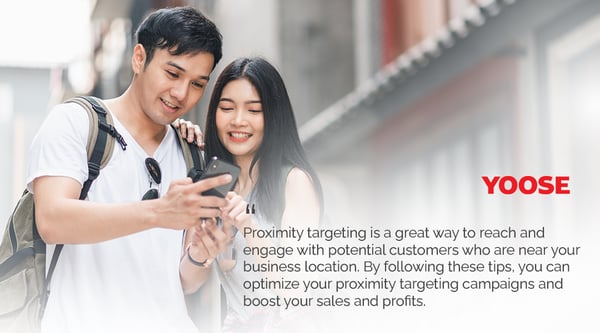Proximity Targeting: A Powerful Way to Reach Local Customers
Proximity targeting is a marketing technique that leverages mobile technology to deliver messages that are relevant and personalized to potential customers who are geographically close to a local business and have a high purchase intent. This technique can help local businesses increase their customer acquisition and retention rates by reaching them at the right time and place with the right offer.
What does proximity targeting mean in location-based marketing?
Proximity targeting is based on the idea of delivering the right message to the right person at the right time and place. It uses mobile devices, such as smartphones and tablets, to detect the location of users and send them tailored ads or offers based on their proximity to a specific point of interest, such as your store, a competitor's store, a landmark, an event, or any other location that is relevant to your business.
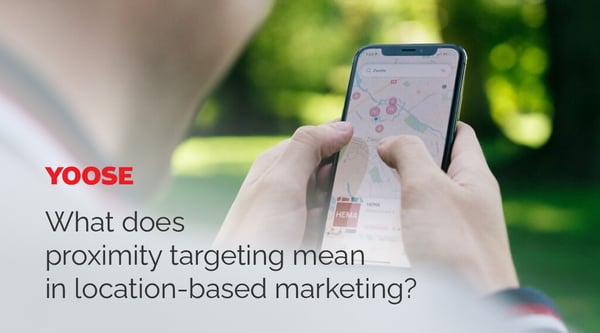
Proximity targeting can be done using various technologies, such as Bluetooth beacons, geo-fencing, WiFi, or NFC. Each technology has its own advantages and limitations, depending on factors such as accuracy, range, cost, battery consumption, and user permission. For example:
- Bluetooth beacons are small devices that emit signals that can be detected by nearby mobile devices. They can provide very precise location data (up to a few meters) and trigger notifications when users enter or exit a predefined area. However, they require users to have Bluetooth enabled on their devices and to have a specific app installed that can receive the signals.
- Geo-fencing is a technique that creates a virtual boundary around a geographic area using GPS or cellular data. It can cover larger areas than beacons (up to several kilometers) and does not require users to have a specific app installed. However, it is less accurate than beacons and can drain the battery of mobile devices.
- WiFi is a technology that allows mobile devices to connect to wireless networks. It can provide location data based on the IP address of the network or the MAC address of the device. It can cover indoor and outdoor areas and does not require user permission. However, it is less accurate than beacons and geo-fencing and depends on the availability and quality of WiFi networks.
- NFC (Near Field Communication) is a technology that allows mobile devices to communicate with each other or with other NFC-enabled objects when they are in close proximity (up to a few centimeters). It can provide very precise location data and enable interactive experiences, such as payments, loyalty programs, or product information. However, it requires users to have NFC enabled on their devices and to tap their devices on the NFC tags.
Why use proximity targeting?
- Increasing brand awareness and visibility by reaching potential customers who are nearby and interested in your products or services.
- Driving foot traffic and conversions by sending timely and relevant offers or incentives that encourage users to visit your store or make a purchase.
- Enhancing customer loyalty and retention by providing personalized and engaging experiences that enhance customer satisfaction and trust.
- Gaining insights into customer behavior and preferences by collecting and analyzing location data that can help you optimize your marketing campaigns and improve your business performance.
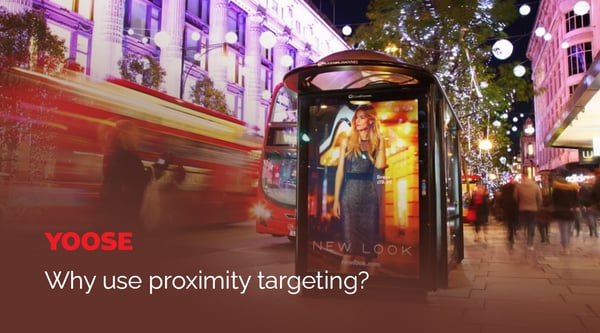
A complete guide of using proximity targeting?
Step 1: Define your goals and audience
Before you start creating your proximity campaigns, you need to have a clear idea of what you want to achieve and who you want to target. Do you want to increase foot traffic, generate leads, promote a special offer, or build brand awareness? Who are your ideal customers and what are their needs, preferences, and behaviors? How can you segment them based on their location, demographics, interests, or purchase history?
Step 2: Choose your geofencing platform and tools
To implement proximity targeting, you need a geofencing platform that allows you to create and manage your campaigns. There are many options available in the market, but you should look for one that offers the following features:
- Easy-to-use interface and dashboard
- Real-time data and analytics
- Customizable geofences and triggers
- Multiple channels and formats (SMS, email, push notifications, etc.)
- Integration with your CRM and other tools
Step 3: Create your geofences and messages
Once you have your platform and tools ready, you can start creating your geofences and messages. A geofence is a virtual boundary that defines the area where you want to target your customers. You can create geofences of different sizes and shapes, depending on your goals and audience. For example, you can create a small geofence around your store to attract nearby shoppers, or a larger one around a competitor's location to lure away their customers.
The next step is to craft your messages that will be sent to your customers when they enter or exit your geofences. Your messages should be relevant, timely, and personalized to the context and the customer. You should also include a clear call-to-action that encourages them to take the next step, such as visiting your store, redeeming a coupon, or downloading an app.
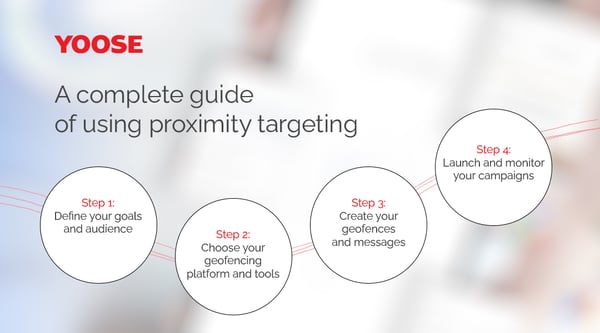
Step 4: Launch and monitor your campaigns
After creating your geofences and messages, you can launch your campaigns and start reaching your customers. You should monitor the performance of your campaigns using the data and analytics provided by your platform. You should track metrics such as impressions, clicks, conversions, revenue, ROI, etc. You should also test different variables such as geofence size, message content, channel, frequency, etc. to optimize your results.
Step 5: Evaluate and improve your campaigns
The final step is to evaluate the effectiveness of your campaigns and make improvements based on the feedback and insights you gather. You should measure the impact of your campaigns on your business goals and customer satisfaction. You should also ask for feedback from your customers using surveys, reviews, ratings, etc. You should use this information to refine your strategy, improve your targeting, and enhance your customer experience.
Challenges
- Privacy and consent: Marketers need to respect the privacy of consumers and obtain their consent before collecting and using their location data. This requires clear and transparent communication and compliance with data protection laws and regulations.
- Accuracy and reliability: Marketers need to ensure that the location data they use is accurate and reliable, and that it reflects the actual behavior and intent of consumers. This requires using high-quality data sources and methods, and avoiding errors and fraud.
- Relevance and value: Marketers need to ensure that the ads they deliver are relevant and valuable to consumers, and that they do not annoy or overwhelm them with too many or inappropriate messages. This requires understanding the context and preferences of consumers, and offering them incentives and benefits for engaging with the ads.

How can proximity targeting be enhanced?
- Define your target radius. Depending on your business type, product, and competition, you may want to adjust the radius of your proximity targeting. For example, if you are a restaurant, you may want to target people who are within walking distance of your location. If you are a car dealership, you may want to target people who are within driving distance of your location. You can use tools like Google Ads or Facebook Ads to set up different radiuses and test which one performs better for your goals.
- Use location extensions. Location extensions are a feature that allows you to show your business address, phone number, and directions on your ads. This can help you attract more clicks and conversions from people who are looking for your business or a similar one nearby. You can also use location extensions to show special offers or promotions that are only available at your location. Location extensions can be added to your ads on Google, Facebook, Instagram, and other platforms.
- Segment your audience. Not all people who are near your location are the same. You may want to segment your audience based on their demographics, interests, behaviors, or purchase intent. For example, you may want to target different ads to people who are searching for your product or service versus people who are browsing social media. You may also want to target different ads to people who are new to your area versus people who are loyal customers. You can use tools like Google Analytics or Facebook Pixel to track and segment your audience based on various criteria.
- Track and measure your results. To optimize your proximity targeting campaigns, you need to track and measure how they are performing. You need to know how many impressions, clicks, calls, visits, and conversions you are getting from your ads. You also need to know how much you are spending and what is your return on investment (ROI). You can use tools like Google Ads or Facebook Ads to monitor and optimize your campaigns based on various metrics and indicators.
- Test and experiment. Proximity targeting is not a one-size-fits-all solution. You need to test and experiment with different variables and factors to find what works best for your business and audience. You can use tools like Google Optimize or Facebook Experiments to run A/B tests or multivariate tests on your ads, landing pages, offers, and more. You can also use tools like Google Trends or Facebook Insights to research and discover new opportunities and trends in your market.
Proximity targeting is a great way to reach and engage with potential customers who are near your business location. By following these tips, you can optimize your proximity targeting campaigns and boost your sales and profits.
Case study
Here are some examples of how different businesses have used proximity targeting successfully:
- McDonald's: The fast-food giant used geo-fencing to target customers who were within a one-mile radius of its restaurants and send them coupons for discounted meals. The campaign resulted in a 7.5% conversion rate and a 6.4% increase in sales.
- Carrefour: The supermarket chain used Bluetooth beacons to send personalized offers and product recommendations to customers who entered its stores and had the Carrefour app installed. The campaign resulted in a 400% increase in app engagement and a 600% increase in app retention.
- Walmart: The retail giant used WiFi to provide free internet access to customers who visited its stores and agreed to receive marketing messages. The campaign resulted in a 50% increase in email opt-ins and a 30% increase in store visits.
- Sephora: The beauty retailer used NFC tags to enable customers to access product information, reviews, tutorials, and loyalty rewards by tapping their phones on the tags. The campaign resulted in a 20% increase in app usage and a 10% increase in sales.
- Nisa: The convenience store chain used geo-fencing to target customers who were within a 200-meter radius of its stores and send them offers for products that were relevant to the time of day, weather, and season. The campaign resulted in a 12% increase in foot traffic and a 9% increase in basket size.
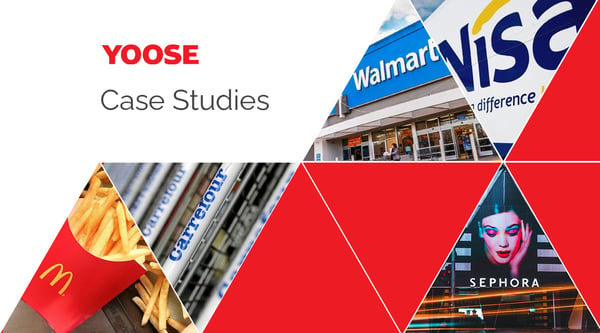
An effective method for local businesses
Proximity targeting is a powerful strategy for local businesses that want to reach customers who are nearby and ready to buy. At YOOSE, we are able to use proximity targeting to help you increase brand awareness, drive foot traffic, enhance customer loyalty, gain insights, and improve your business performance by using mobile technology to deliver relevant and personalized messages.
